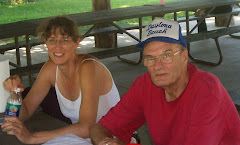
These may be obvious species to many of us, but I need my youngest to learn them too. So here's #25,
CORN. And this corn is going to feed chickens and cows, and will not be going into anyone's fuel tank.

26 & 27. The crop on the left is WINTER
WHEAT nearly ready to harvest. The crop on the right is
HAY.

28. A bean field. When I was growing up, and my parents talked about the "bean fields," I always thought it meant green beans. Nope. In the midwest, virtually all the field-crops are corn, hay, wheat, and
SOYBEANS. Other crops are seen occasionally. I took the picture of the bean field just as the soybeans were flowering. Aren't the soybean flowers pretty?

 These may be obvious species to many of us, but I need my youngest to learn them too. So here's #25, CORN. And this corn is going to feed chickens and cows, and will not be going into anyone's fuel tank.
These may be obvious species to many of us, but I need my youngest to learn them too. So here's #25, CORN. And this corn is going to feed chickens and cows, and will not be going into anyone's fuel tank. 26 & 27. The crop on the left is WINTER WHEAT nearly ready to harvest. The crop on the right is HAY.
26 & 27. The crop on the left is WINTER WHEAT nearly ready to harvest. The crop on the right is HAY. 28. A bean field. When I was growing up, and my parents talked about the "bean fields," I always thought it meant green beans. Nope. In the midwest, virtually all the field-crops are corn, hay, wheat, and SOYBEANS. Other crops are seen occasionally. I took the picture of the bean field just as the soybeans were flowering. Aren't the soybean flowers pretty?
28. A bean field. When I was growing up, and my parents talked about the "bean fields," I always thought it meant green beans. Nope. In the midwest, virtually all the field-crops are corn, hay, wheat, and SOYBEANS. Other crops are seen occasionally. I took the picture of the bean field just as the soybeans were flowering. Aren't the soybean flowers pretty?



I love the bean fields after they turn yellow. Isn't that the prettiest color? All that golden yellow shining in the late summer sun.
ReplyDeleteI like the fields of alfalfa, too. I've always wanted to go walk in it to see what it feels like.